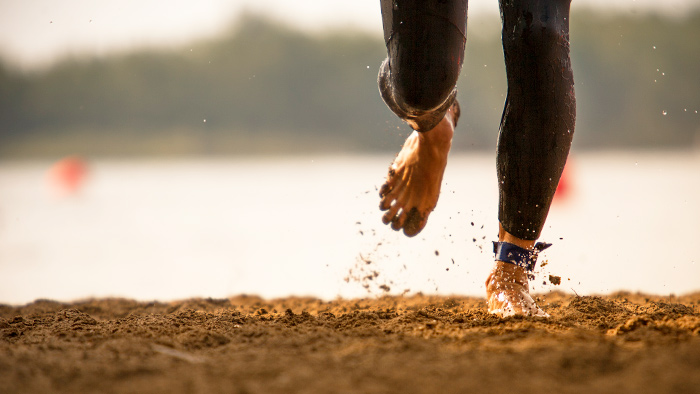My first Olympic distance triathlon was nothing like I expected it to be. I chose the race in Columbia, Maryland because of its location, promise of warm, early May temperatures, and a challenging course. On race day, I faced freezing cold water and wind gusts up to 30 mph. Obviously that was not the challenge I was looking for, but it was what I was given. I adjusted my goals and strategy, survived the race, and even placed third in my age group. Although the experience was nothing I thought it was going to be, I learned quite a bit about racing the Olympic distance in triathlon.
Mindset
As we all know, race day makes no promises and when you are competing in three different disciplines within one race, a lot can happen. From small issues like leaky goggles to bigger problems like a flat tire or bad weather, you have to be ready to adapt. Instead of expecting a perfect race, be flexible and overcome these obstacles as they arise. Be prepared by bringing an extra pair of goggles and know how to fix a flat tire. You cannot control the weather, other competitors, or just plain bad luck, but what you can control is how prepared you are, both mentally and physically, and your attitude.
Get in a Good Warm-Up
A good warm-up is essential, especially in unfavorable race conditions. Complete a 15 to 20 minute easy paced run and throw in 5 to 10, 30 second strides to get your legs turning over. Time this so you end with about 30 minutes until your start time, which will allow you to pull on your wetsuit and get down to the water.
If you are allowed to get into the water prior to the swim, do so, unless it’s too cold. You do not want to freeze while standing on the beach waiting for your wave. If you are not allowed in the water prior to the start, or the conditions don’t warrant it, get down to the water and splash some on your face, dip your goggles in, and get a feel for what that first plunge will feel like.
The Swim
Unless you swam competitively, the swim is typically the most difficult leg. To help alleviate your anxiety, start out conservatively and expect some contact in the first 200 yards or so. Just go with it and swim easy until the pack spreads out and you can find your own space. Think long strokes, breathe easy, and take it one buoy at a time. Sighting is key, especially if there are few buoys marking your path. Look up often and stay on course. When you finally close in on the last five minutes or so, pick up the pace and start thinking about your transition to T1.
Transition 1
You are racing so don’t just walk to T1. Strip down the top of your wetsuit as you are running to the transition area to save time. Practicing your transitions ahead of time will help you know exactly what order you will put on your shoes, helmet, sunglasses, etc. I sprint into and out of transition even if everyone else is jogging or walking. This is a great way to make up some time. I have had races come down to seconds and have won because of my faster transitions.
The Bike
Once you mount the bike take a minute or two at an easy pace to slow your heart rate down to something manageable. Don’t be concerned if others are passing you. Remember that you need to stick to your own plan. Good pacing starts the second you start pedaling.
The goal of the bike ride is to stay in Z3 for the majority of the ride. This is an intense effort, so make sure that you are hitting similar efforts in your training. Make sure you get as aero as possible on straightaways and downhills. If the course has climbs, shift into your lower gears and spin at a higher cadence. Get out of the saddle just before the final crest of the hill and push hard up to the top. By downshifting and pedaling at a higher cadence you will keep your legs from feeling like lead in the first half mile of the run.
In the last few minutes on the bike, start thinking about T2.
Transition 2
This should be your fastest transition of the day. Dismount as quickly and safely as you can and then simply take off your helmet and shoes, pull your running shoes on and, if you have a bib belt grab it and put it on as you run out of transition. Remember that every second counts.
The Run
Running off the bike is not the same as just running. Your training should include what are known as brick workouts so you will know what your legs feel like trying to run after having ridden 25 miles.
On race day, do not go out too fast. It’s far better to start off a little slower and save some energy and leg turnover for the last mile of the run. During the tough final miles, having some mantras ready can help you mentally get through the miles. When you hit mile four, it’s completely normal to feel like the wall is rising up to meet you, but it will pass. By mile five you will start having images of the finish line and, if you can, this is where you want to steadily start increasing your pace. Give the run everything you have in the last quarter mile and leave it all out on the course.
Olympic distance triathlons are a great accomplishment for any triathlete. The pace, intensity, and distance combine for a challenge that will put your body and mind to the test. With some smart preparation and planning, you can reach your goals.



